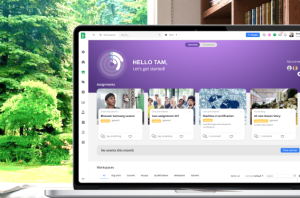With the right tools, companies can turn the challenges of globalization and digitalization into a world of opportunity.
“I need the data to move forward with the project. Fax it to me and all the team members. ASAP.”
Imagine having that conversation with one of your millennial employees. Something that sounded perfectly reasonable twenty years ago sounds ridiculously antiquated and inefficient today. As the workforce becomes increasingly complex and global, communication is undergoing yet another transformation, this time from email to company social communication networks, or social intranets.
Social intranets are so effective, that some people are even adopting them at home. In “The Slackification of the American Home”, Melissa Mazmanian, an informatics professor at UC Irvine states, “The way that we imagine knowledge work and more and more kinds of work is really about coordination and collaboration across distance, across people’s different time commitments, managing attention, figuring out who’s going to do what when,” she says. This is true of the workplace too. With the right tools, companies can turn the challenges of globalization and digitalization into a world of opportunity.
How social collaboration can benefit the workplace
Managing a global workforce
Cloud technology has disrupted the dependence on a physical workplace, and companies are becoming increasingly global with workers in multiple locations, time zones and even countries. Managing a distributed workforce can be a challenge, and you may find yourself struggling to track employee output and performance across multiple locations. Keeping a global or regional team up-to-date and informed can also be difficult and time-consuming. With a company social intranet, you can create channels where employees can share information on a given topic or collaborate on projects, no matter where they are. You can also post company videos and documents on your channels to make sure that your entire team is informed, as well as stay on top of what each team member is working on. Social collaboration tools also make it easy to recognize and celebrate the contribution of workers and colleagues, such as exceeding sales goals or service excellence, and give them kudos for their hard work.
In other words, social intranets make it easy to:
- Keep your distributed workforce informed and up-to-date.
- Track employee output and performance and recognize achievement.
- Encourage collaboration between employees, locally and globally.
Knowledge retention
With unemployment at a historic low, the workforce is becoming increasingly dynamic and turnover is high. In 2018, the average time that a salaried worker had been with their current employer in the US was only 4.2 years. The high turnover rate makes retaining company knowledge a challenge, but at the same time, it becomes more important than ever. For example, onboarding new employees is easier and more efficient when companies retain knowledge. Retaining knowledge also prevents the competition from immobilizing your business by hiring away key talent.
Social intranets encourage workers to share their knowledge by making it fun and intuitive. Even if information is documented in an informal note or chat, and isn’t indexed, robust search capabilities enables employees to find the information they need when they need it. Investing in knowledge retention allows employees to utilize and build corporate knowledge rather than corporations using and becoming dependent on employee knowledge.
Basically, when you use a social intranet:
- Critical knowledge stays with the company, not the employee.
- New employees are onboarded more quickly.
- Current employees can access the knowledge they need more efficiently.
User engagement
Social intranets help employees become more organization-oriented by making it easy for disparate teams to interact in real-time, collaborate with specific groups and maintain cross-platform availability. Unlike email, social platforms include fun ways to engage colleagues and share information using videos, GIFs, podcasts and slide decks. When you post content, your colleagues can ask questions or leave comments and emojis so you can gauge how your content is being received.
And it’s not all work! There’s space for informal collaborations and connections as well, creating cohesion and a sense of belonging in the organization.
To sum it up, use your social intranet to:
- Engage remote teams.
- Build team and company cohesion.
- Have fun!
Want to find out how Blossom’s organizational management platform can support your business with digital social collaboration tools? Contact us today.








